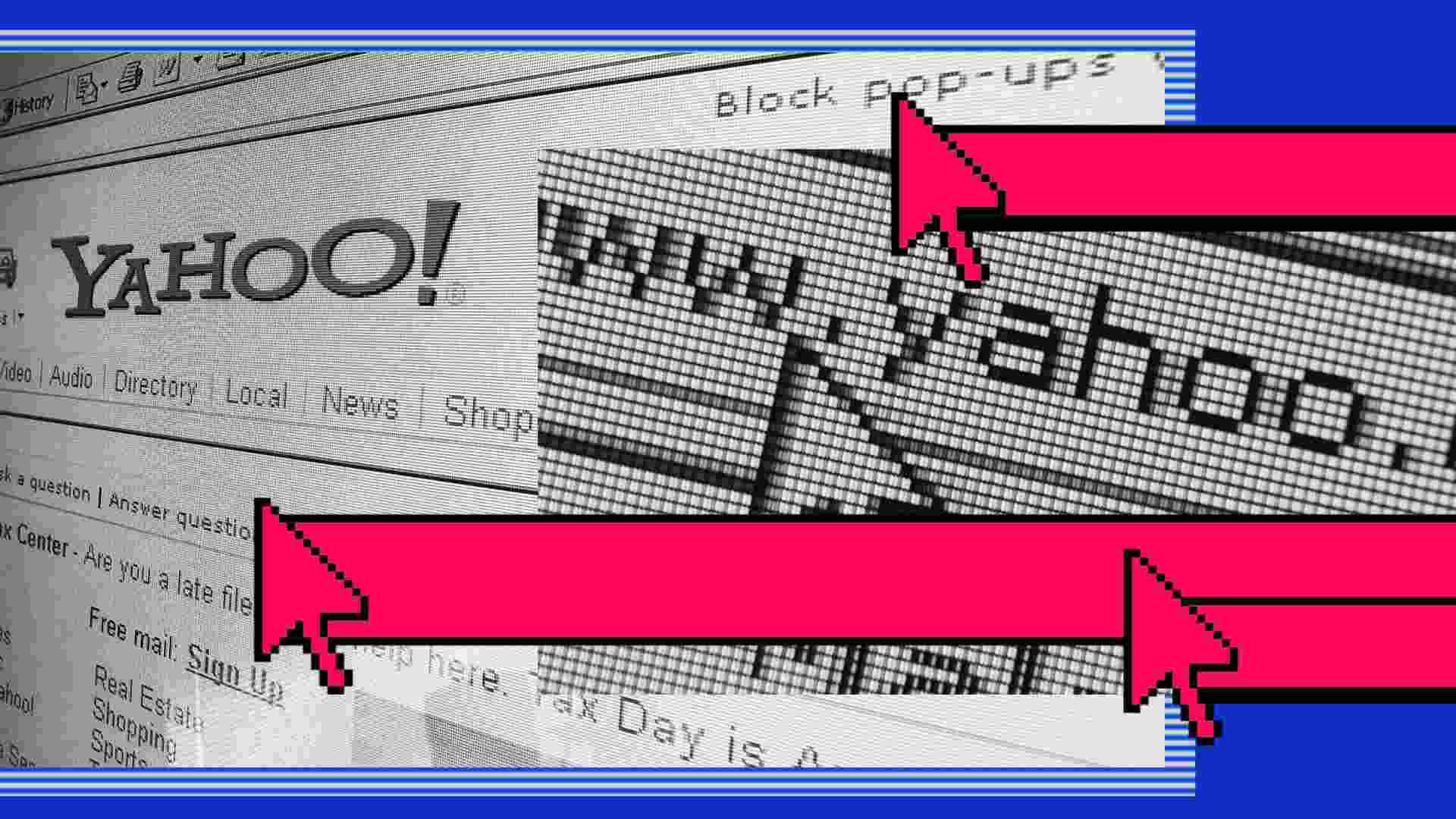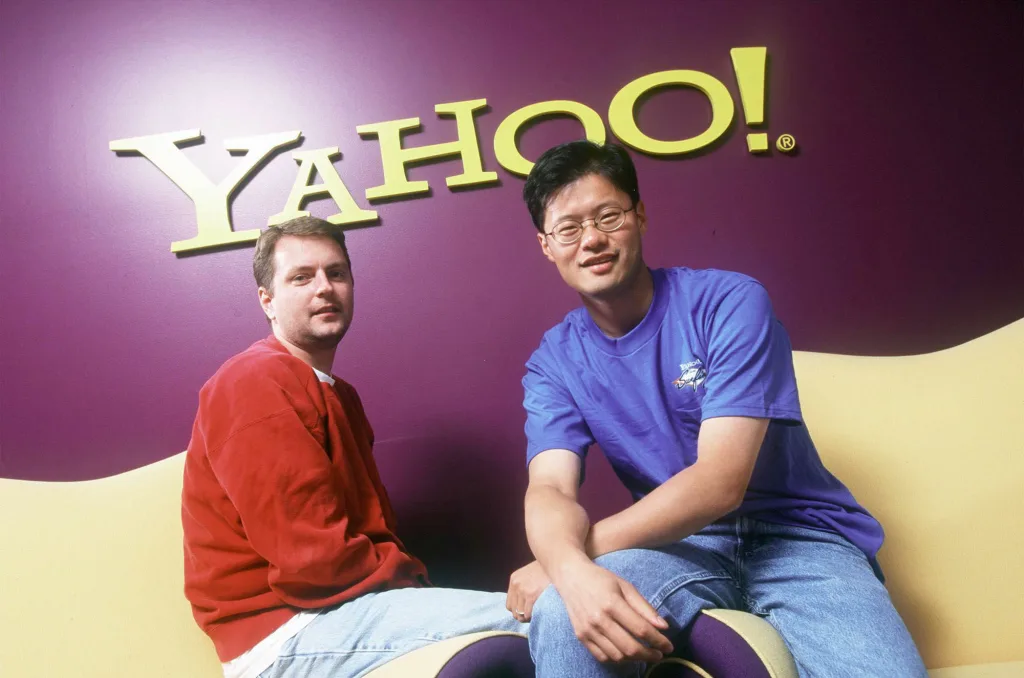- | 8:00 am
Yahoo was once the king of the internet. What happened?
Yahoo in the early days was like a kid in a candy shop: It had unlimited resources and opportunities, but it never heard the word “no.”

The story of Yahoo began with a “B.”
Jerry Yang and David Filo first met when both were students at Stanford in 1989. Filo was a teacher’s assistant in a computer architecture class in which Yang was enrolled. Yang, a self-described type-A student, received a B on his first midterm in the class. Incredulous, he went to the TA’s office hours to dispute the grade. “The story is, Filo gave me my first B. That’s how I met him,” Yang said in a 2017 interview.
The two became close during an academic trip to Japan in 1992. They came back to their classmates buzzing about a new software called Mosaic, the first popular graphical browser for the web. Essentially, the software opened up an entirely new world. They were quick to play with the tech as they worked toward their doctoral degrees.
But as time went on, they were in fact preoccupied with something that would prove to change the course of the internet itself: a website called “Jerry’s Guide to the World Wide Web.”
This story is part of 1994 Week, where we’ll revisit some of the most interesting and confounding developments in tech 30 years ago.
Founded in 1994, Jerry’s Guide to the World Wide Web acted as an online directory of other websites, organized in a hierarchy. Filo or Yang would find sites and place them in layers of subcategories. The internet was relatively sparse in the early days, but new websites were popping up each day. The guide proved to be extremely popular. Yang and Filo compiled a robust directory of more than 2,000 sites by September 1994 and received 50,000 searches a day, according to the Internet History Podcast. By the end of 1994, they received a million hits. As it grew, the two knew they needed a better name. They settled on Yahoo!, which stood for “Yet Another Hierarchical Officious Oracle.” Yahoo.com launched in 1995 and was incorporated in Sunnyvale, California.
Almost immediately, the company was a hit. “It was as if Yang and Filo had opened a lemonade stand in a hayfield and a year later found themselves surrounded by skyscrapers,”reads a 1995 Newsweek article. “They were positioned in exactly the right place during the Year of the Internet.”
Before Yahoo went public in 1996, it had priced its initial public offering at just $13 a share, but investor enthusiasm was rampant. But when it opened its first day of trading, shares soared to $24.5 apiece and finished the day up 154 percent from its offering price. It represented a market cap of $848 million.

Yahoo started rapidly acquiring companies in an attempt to morph beyond a search engine into a complete internet service company. These rapid fire acquisitions had a hit-or-miss track record. On the one hand, Yahoo nabbed Four11, which eventually served as the foundation of Yahoo Mail. On the other hand, it spent $4.58 billion in stock on a site called Geocities in 1999, only to pull the plug a decade later. Still, Yahoo continued to climb, with share prices hitting $118.75 in January 2000 At one point Yahoo was worth over twice as much as Disney, Bloomberg reported.
But what many didn’t realize was that these lofty valuations and investments into internet companies that weren’t making money were feeding a bubble. And that bubble was just about ready to pop.
A SERIES OF BAD BUSINESS DECISIONS
The markets in the late ‘90s were going wild over the seemingly endless IPOs of new internet firms. But most of these companies wouldn’t generate any revenue or turn profits. And once the funding dried up, it was clear these companies didn’t have the self-sustaining funds to keep operating.
By 2000, things crashed. The tech-heavy NASDAQ gave up essentially all of its gains from the tech bubble peak. Shares of Yahoo dropped to $4.06.
Yahoo managed to survive the bubble burst, but it was never the same. The company had brought in Terry Semel to lead as CEO in May 2001, which helped push it toward a rebound for a bit. But the company had made a series of bad business decisions that it struggled to move forward from.
Yang served in a number of leadership positions, including CEO, but stepped down in 2008 after refusing to sell the company to Microsoft. He left Yahoo’s board four years later. Filo had a seat on the board, but left in 2017 after the company was acquired by Verizon.
THIRTY YEARS LATER
At the beginning, Yahoo was ahead of the curve in nearly every category. Yahoo Briefcase offered cloud storage before Dropbox. Yahoo Music ran on a freemium model before Spotify. But Yahoo failed to fully commit to those segments, opening the door for smaller startups to claim a market share.
“Yahoo had spread itself very thin across a whole lot of areas, but then would cut things before they worked,” Yahoo Finance President and GM Tapan Bhat tells Fast Company. Bhat returned to Yahoo in 2022 after having spent 2005 to 2010 at the company, helping usher in a key redesign of its homepage.
Still, some segments have continued to perform: Yahoo Finance allows investors to track stocks; Yahoo Sports keeps fans up-to-date on scores; Yahoo News pulls the top headlines into a central spot.
“It’s always been there delivering for people, and that’s easy to take for granted,” Jim Lanzone, who took over as Yahoo CEO in September 2021, told Fast Company in an interview at the company’s new San Francisco office in April. He rolled off a number of stats: Yahoo Finance is still the number one business and finance news network. Yahoo Mail is the number two email services property. Yahoo News is the number one news/information property in terms of reach.
It’s impossible to market the brand back to relevance, Lanzone says. (Although it doesn’t hurt that American culture is also in the midst of a 2000s-era resurgence.) The answer, he says, lies in the products. According to Lanzone, by the end of the year, the company should have new versions of all of the products it inherited. Yahoo, for example, earlier this month unveiled a redesigned Mail experience that includes AI-powered message summaries.
“If we do an amazing job and are the best in each one of these categories, I think the Yahoo brand will have a renaissance alongside that,” Lanzone says. “Not from asking people to pay attention to Yahoo again, but by making them pay attention to the products that we’re building.”
Bhat likened Yahoo in the early days as being a kid in a candy shop: It had unlimited resources and opportunities, but it was also far too easy to try far too much. Compared to its early heyday, the company appears far more focused. “There’s a sequencing discipline that the company didn’t have at that time,” Bhat says. “There is a focus that the company didn’t have.







































